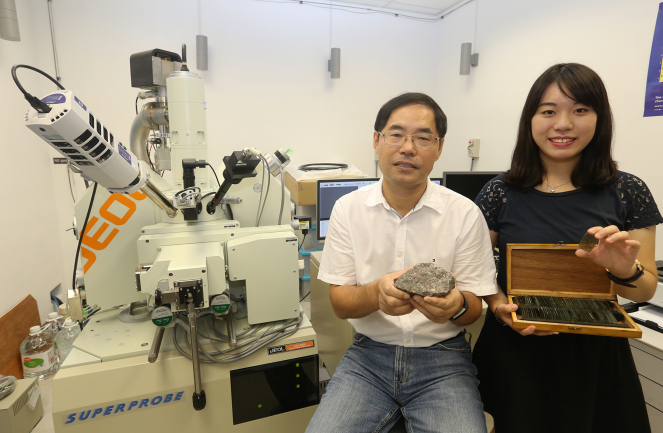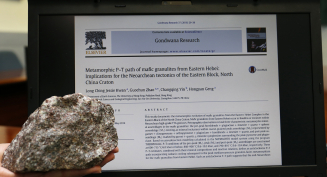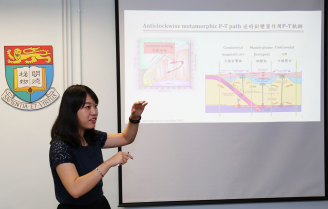Media
HKU Earth Sciences student research on metamorphic rock in North China published in leading academic journal
09 Sep 2016

Miss Jessie Kwan Long-ching (left), under the supervision of Professor Zhao Guochun, conducts her research with the aid of the Electron Probe Micro-Analyzer (EPMA).
Miss Jessie Kwan Long-ching, a year-4 undergraduate student in the Department of Earth Sciences, the University of Hong Kong (HKU), has just published a paper entitled “Metamorphic P-T path of mafic granulites from Eastern Hebei: Implications for the Neoarchean tectonics of the Eastern Block, North China Craton” in Gondwana Research, a leading peer-reviewed international journal (2015 SCI impact factor = 8.743). Jessie’s paper was produced from the result of her Final Year Project in which she carried out a detailed pressure-temperature evolution study on the ~2.5 billion year old high-grade metamorphic rocks (called granulites) from Eastern Hebei Province (China). The result shows that the ~2.5 billion year old mafic granulites from the Taipingzhai area experienced metamorphism that is characterized by an anticlockwise P-T path involving isobaric cooling, reflecting an origin related to the underplating of mantle-derived magmas, not consistent with subduction and collision processes under a plate tectonics regime. Jessie’s achievement will further inspire HKU undergraduate students’ interest in doing scientific research and having their research outputs published in international journals.
Jessie’s research was supervised by Professor Zhao Guochun, who is an outstanding researcher in the supercontinent and metamorphic petrology fields, and has published more than 260 papers cited 18000 times. Professor Zhao won the State Natural Science Award (Second Prize) in 2014 and was selected as the Laureate of the 29th Khwarizmi International Award in 2016. (For details, please see the following links.)
As one of three major types of rocks (igneous, sedimentary and metamorphic rocks), metamorphic rocks are formed from the transformation of existing rock types, in a process called metamorphism that happens in the deep earth due to the change of pressure, temperature and other physical and chemical conditions. Jessie has become very interested in the tectonic setting and process of metamorphic rocks since she took the course “Metamorphic Petrogenesis” taught by Professor Zhao, leading her to take metamorphic study as her research topic. She invited Professor Zhao to be her supervisor of her final year project entitled “Metamorphic P-T path of mafic granulites from Eastern Hebei: Implications for the Neoarchean tectonics of the Eastern Block, North China Craton”.
Situated about 200 km east of Beijing and covering an area of more than 10,000 square meters, Eastern Hebei is considered as one of the most ideal high-grade terranes to study the formation and evolution of Precambrian (>542 million years ago) crust as it consists of voluminous Archean (≥2.5 billion years ago) rocks. Previously, geologists carried out extensive investigations on metamorphic terranes in North China, including Eastern Hebei. However, former studies were mainly based on inconsistent and conventional methods (geothermobarometric calculations) to determine the pressure-temperature conditions of metamorphic terranes, which may result in large errors. It therefore remains highly controversial whether these findings reflect the true metamorphic history of the area instead of artifacts of traditional calculations.
This forms the justification for Jessie’s research in which she applied the THMOCALC phase-equilibrium modeling technique to pressure-temperature calculations of different mineral assemblages and metamorphic stages recognized in the Eastern Hebei mafic granulites, which yielded accurate results of metamorphic pressure-temperature conditions.
Under Professor Zhao’s supervision, Jessie designed detailed research plans which include thin-section examination under the microscope, mineral composition analysis using new EPMA machine in the department, data processing, thermodynamic modelling and finally geological map drawing.
Reflecting on her recent research experience, Jessie said: “Besides the supervision of Professor Zhao, the Earth Sciences Department and the Faculty of Science have fully supported my research by providing research funds as well as advanced equipment such as petrological microscopes and Electron Probe Micro-Analyzer (EPMA) which was newly introduced to the Department and is the only one of its kind in Hong Kong. The data used in this particular research was the first batch of dataset successfully released by this machine. HKU has always encouraged research not only at the postgraduate level but also for undergraduates. As a beginner to the world of academic research who knows little about mineralogy, research and equipment, I am grateful to the tutors, postgraduate students and lab technicians in the department for their generous help and support.”
As her supervisor, Professor Guochun Zhao is very satisfied with Jessie’s achievement and hopes more and more HKU undergraduate students can publish their research outcomes in international journals in future.
Related information:
Jessie Kwan Long-ching’s research paper “Metamorphic P-T path of mafic granulites from Eastern Hebei: Implications for the Neoarchean tectonics of the Eastern Block, North China Craton” in Gondwana Research.
http://www.sciencedirect.com/science/article/pii/S1342937X16300867
Website of Professor Zhao Guochun:
http://www.earthsciences.hku.hk/people/academic-staff/prof-zhao-g-c
HKU Professor Zhao Guochun becomes the first geologist to receive the Khwarizmi International Award (First Class). 09 Mar 2016
http://hku.hk/press/press-releases/detail/14245.html
Nine HKU academics named amongst the world's most highly cited researchers. 2 Oct 2015
http://hku.hk/press/press-releases/detail/13320.html
Five HKU academics named amongst the world's most influential researchers. 13 Jul 2014
http://hku.hk/press/press-releases/detail/11441.html
Media enquiries:
Communication and Public Affairs Office Ms Rhea Leung (Tel: 2857 8555/ 9022 7446; Email: rhea.leung@hku.hk) or
Faculty of Science Ms Cindy Chan (Tel: 3917 5286/ 6703 0212; Email: cindycst@hku.hk).


